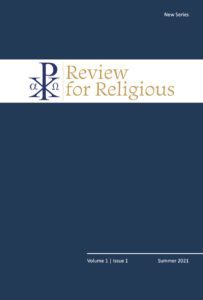We invite you to preview Review for Religious 2, no. 2 (Summer 2022)!
The latest issue of the print journal is out! It features a diverse set of articles, including:
- a contemplation of the significance of St. Joseph for consecrated life;
- reflections on burnout via an analysis of the the life of a historical woman religious;
- drawing out the impact of Ignatian spirituality on the social ethics of Pope Francis, and more!
You may preview the issue by downloading the table of contents, reading the sample article, or previewing excerpts from all the articles below.
Excerpts From the Summer 2022 Issue
It is always somewhat perilous to attempt to explain the ethical stances of any one person in terms of an underlying spirituality. In the end, only that person is qualified to give an account of how he or she bridges the distance between inner spiritual perspectives and outward-facing ethical commitments.
In Madeleva’s life, we also witness the sad irony of burnout culture—that is, how work conditions and worker ideals give rise to “work martyrs.” Mandell highlights how Madeleva’s drive to live a life of service to God is precisely what exhausted her, often to the point of inhibiting her ability to serve God. In view of Malesic’s sketch of burnout, it is not romantic but concerning that Madeleva came to see her exhaustion—much of which was contingent on her constant overwork—as a holy “retreat” because it was her only access to the spiritual practices that most connected her to the God she longed to serve.
Joseph’s title of carpenter is a translation of Greek tekton, which also means artisan or craftsman (Mt. 13:55). The words “architect,” “architectural” and “tectonic” are also derived from the same root. Tekton is related to the building structure or the geological structure of the soil. The word architekton, which means master builder or architect, is used in 1 Cor 3:10. The use of tekton—not architekton—for Saint Joseph in Mt 13:55 is probably for a double purpose: First, to show that he is humbler and simpler than an architect. Tekton is, in this case, related more to his simplicity. Second, to elucidate his being as the social, spiritual, and cultural basis of his family since the word tekton evokes the basic structure of a building or soil. It is so because Joseph was socially and culturally an ideal paterfamilias and spiritually a guru which made Jesus advanced in wisdom (Lk 2:52).
Francis gives more depth to such questions when he asks us to leave “our own comfort zone in order to reach all the peripheries in need of the light of the Gospel” (EG, 20). This means addressing secularization. While a lot of ink has been spilled on defining that word, it is basically understood as a weakening of traditional religious faith, affiliation, and practice.
This essay responds to the Synod on Synodality’s vision of a synodal Church and its invitation to recognize this objective being achieved within the method of the journeying together of the People of God.
